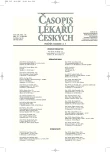The Information Value of Detection of Borrelia Antibodies in the Healthy Blood Donors and in the Population at Risk
Informační hodnota průkazu antiborreliových protilátek u zdravých dárců krve a rizikové skupiny populace
Východisko.
Geografické diference jednotlivých druhů klíšťat a variantní kmeny borrelií znesnadňují komparaci zkušeností domácích se zahraničními. Autoři se pokusili některé literární informace podpořit vlastním pozorováním a uspořádali studii zaměřenou na stanovení antiborreliových (AB) protilátek ve vybraných populačních vzorcích.
Cílem práce bylo zjistit a statisticky zhodnotit :
a) rozdíl v rozložení hodnot hladin AB v souboru probandů z rizikového a nerizikového prostředí (šumavští lesní dělníci a pražští dárci krve) metodou ELISA, b) četnost kousnutí klíštětem v rizikové a nerizikové skupině, c) určit a statisticky zhodnotit četnost probandů se zvýšenou hodnotou hladin antiborreliových protilátek v domácí populaci metodou ELISA a četnost probandů s nenormální hodnotou metodou Western blot (WB).
Metody a výsledky.
Ve skupině pražských dárců krve (kontrolní skupina) bylo vyšetřeno celkem 200 probandů, z toho 100 mužů a 100 žen.V rizikové skupině jsme vyšetřili celkem 71 probandů ze šumavského polesí, z toho bylo 39 mužů a 32 žen. Krevní vzorky byly vyšetřeny v Národní referenční laboratoři pro lymeskou borreliózu. U všech vzorků byla použita metoda ELISA NRLB KC 90. Ke konfirmaci byla použita metoda Western blot.
Závěry. Na základě písemnictví z Evropy a USA lze zobecnit i přes některé naše zkušenosti:
1. regionální rozdíly nejsou významné, pokud nejde o vysoce riziková teritoria či „profesionální expozici“; 2. není významný rozdíl mezi muži a ženami; 3. je třeba značné obezřetnosti při srovnávání kontrolní a rizikové skupiny; podmínkou takové komparace je přesné definování charakteristik obou skupin.
Klíčová slova:
klíště, kmeny borrelií, antiborreliové protilátky.
Authors:
P. Bartůněk 1; K. Goričan 1; T. Veiser 1; V. Mrázek 2; P. Vařejka 2; D. Hulínská 3
Authors‘ workplace:
IV. interní klinika 1. LF UK a VFN, Praha
1; II. interní klinika 1. LF UK a VFN, Praha
2; Národní referenční laboratoř pro lymeskou borreliózu SZÚ, Praha
3
Published in:
Čas. Lék. čes. 2007; 146: 603-607
Category:
Original Article
Overview
Background.
Geographic differences of particular species of ticks and variant strains of Borrelias impede the comparison of local and foreign experience. The authors tried to support some literary observations with their own results and designed a study aimed at determination of anti-Borrelia antibodies (AB) in the selected population samples. The goal of the study was to find and statistically evaluate: a) difference in distribution of values of AB in the sample of probands from the risk and nonrisk environment (foresters in Šumava and Prague blood donors, respectively) by means of ELISA method, b) tick bite frequency in the risk and non-risk groups, c) to determine and statistically evaluate the prevalence of probands with increased levels of antiborrelial antibodies in the local study population by ELISA method and the prevalence of probands with non-normal values found by Western blot (WB) method.
Methods and Results.
In the group of Prague blood donors (control group), in total 200 probands were examined; in the risk group, 71 probands from Šumava forest were examined. Blood specimens were examined in the National Reference Laboratory for Lyme Borreliosis in Prague. In all specimens, ELISA NRLB KC90 was used. Western blot assay was used for confirmation.
Conclusions.
On the basis of literature review from Europe and USA, it is possible to generalize the following, despite some equivocations: 1. regional differences are not significant, with the exception of high-risk territories or „occupational exposure“; 2. there is no significant difference between males and females; 3. considerable caution is necessary in comparing the control and risk groups; prerequisite for such comparison is defining the characteristics of both groups.
Key words:
tick, borrelia strains, antiborrelial antibodies
Labels
Addictology Allergology and clinical immunology Angiology Audiology Clinical biochemistry Dermatology & STDs Paediatric gastroenterology Paediatric surgery Paediatric cardiology Paediatric neurology Paediatric ENT Paediatric psychiatry Paediatric rheumatology Diabetology Pharmacy Vascular surgery Pain management Dental HygienistArticle was published in
Journal of Czech Physicians

- Advances in the Treatment of Myasthenia Gravis on the Horizon
- Metamizole at a Glance and in Practice – Effective Non-Opioid Analgesic for All Ages
- Metamizole vs. Tramadol in Postoperative Analgesia
- Spasmolytic Effect of Metamizole
- The Importance of Hydration in Wound Healing
Most read in this issue
- Milestones of Cardiovascular Therapy. IV. Reserpine
- Clostridial Sepsis and Gas Gangrene of the Abdominal Wall After Cholecystectomy
- Use of Capillary Electrophoresis in the Clinical Research
- Ten Years Since the Successful Introduction of the First Monoclonal Antibody (Rituximab) into the Therapy of Lymphomas
